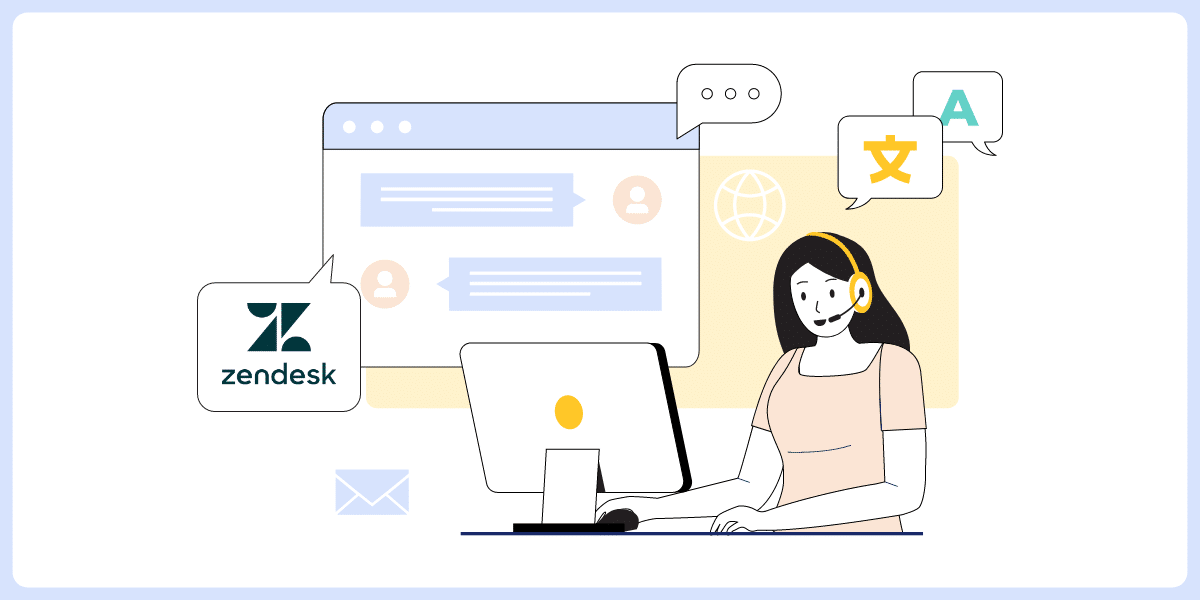Home » E-commerce Localization » A 5-Step Guide to eCommerce Multilingual Customer Support
A 5-Step Guide to eCommerce Multilingual Customer Support
- | Aiswarya Menon

Table of Contents
Amy, who lives in London and is running an eCommerce store, notices an interesting trend in her business from the last quarter.The analytics suggest that her business website is generating traffic from multiple foreign cities in India and France. Not only are these foreign customers visiting her website but some of them are even purchasing the listed products on the website. Now, just like any sane business owner would do, Amy wants to tap the two giant markets in India and France. To cater to these audiences, she needs to transform her business collateral & customer support to the languages that her potential customers speak.
To build multilingual support, Amy tries to envision a strategy. But she finds umpteen hurdles in her way, such as:
- Lack of multilingual customer support agents
- Expensive & less-sustainable process of setting up of call-centers in India and France
- Out-of-budget customer-experience localization costs
- Translating the entire website into foreign languages
- Complex & confusing live chat with customers in their local languages
- Drawbacks of machine translation
This never-ending vicious obstacles-loop leaves Amy all perplexed and staggered. She eventually succumbs to the adversities & quits her dream of making her eCommerce company a global brand.
Though Amy is a fictional character in our story, we know that she is relatable to many. A number of business owners, like Amy, want to go international but face multiple challenges when it comes to localizing customer experience.
If you are an eCommerce business owner, ending up like Amy would be the last thing you would want for yourself, won’t you? Thus, to help you from entering into the “Amy-Zone”, we are going to provide you with a 5-step guide to building multilingual customer support for your eCommerce in this blog post.
Before we jump into the guide, let’s first understand how multilingual customer support can help an eCommerce business thrive. Let’s go!
6 Reasons Why Ecommerce Businesses Should Build Multilingual Customer Support
There are more than 7100 languages spoken in the world. Imagine the kind of growth your eCommerce business can achieve even if it targets only 7 of them.
Quite a dream, isn’t it? Apart from getting cashed up & being recognized internationally, there are several other benefits of providing multilingual support to customers. Let’s discuss the most important ones:
Helps businesses build authority:
One may think that since English is the most spoken language in the world, a website designed in English language would be enough to woo customers. But the research suggests otherwise.
A CSA Research survey reveals that out of 3,000 online shoppers across 60 countries, 60% disclosed that they rarely or never buy anything from English-only websites. Additionally, 76% prefer to purchase products with information translated into their native language.
Even people who understand English would likely find the information in their native language more relatable and trustworthy. This is why localization has become so essential for global eCommerce businesses.
Cost-effective content marketing:
85% of online shoppers perform some kind of online search before making a purchase. No wonder, organic marketing with high-quality blog posts are still relevant in 2022 and only growing its authority over paid ads and traditional marketing. And content marketing, being 62% less expensive than the paid ads, acts like the icing on the cake!
Global eCommerce websites can also leverage this strategy to cater to their target audience. They can translate their digital content to their target native languages and win more trust by providing a rich multilingual customer experience at their online stores. That too, without burning a hole in their pocket!
Fight off competition:
If your business’s origin market is too crowded, change your radar, not your business. Shift focus on the markets that are untapped from your competitors and win your game like a pro.
What if the foreign markets have competitors too, you may ask? Let us tell you that there’s a huge gap in this multilingual customer support dynamic.
A research from Intercom suggests that though 88% of support teams offer customer support in more than one language, only 28% of end users say they actually see support offered in their native language.
This mirrors that only a few companies are actually able to provide quality multilingual customer service, and there’s a huge demand to fill. You can win such markets by providing extraordinary native-language customer support.
Increase your SEO reach:
It’s a no-brainer that your well-structured content can rank on the search engine page, as long as people are searching for the topics you talk about.
When you talk about those topics in multiple languages, the spectrum of your website traffic also gets rainbowed from different parts of the world. This can eventually increase your website reach and improve the SEO massively. The more people would land to your website, the more leads it generates for you.
Lesser shopping cart abandonment:
Setting up a live chat support, and responding in their native language, at the checkout page can increase the convenience for customers. They would feel empowered and confident while purchasing the products that they have added to their carts. (We will talk about how you can set up a feasible multilingual live-chat support on your website in the guide section)
Catching the pulse of a native culture:
Neil Patel considers restructuring a blog post in a language that your core audience speaks is one of the proven ways to increase the website traffic. Your target customers will find your content relatable and are likely to advocate & share it with others as well.
This could eventually start sending a message to your target group that your website understands their culture and it would get easier for you to convert them to your paying customers.
5-Step Guide: How To Build a Robust, Realistic & Cost-effective Multilingual Customer Support for Your eCommerce Business
Now that you have understood the importance of providing multilingual customer support to the global customers, without any further ado, let’s get you to the much-awaited guide to building one for your eCommerce.
Identify your target languages (and second languages)
First thing first, do the KYC (Know-Your-Customer) before everything else. You might want to expand your business to every corner of the world, but starting small is always a sane thing to do in business.
Just like we had incorporated that Amy story in the starting of this blog post, study the previous analytics of your business and see if your business is getting attention from a significant region of the world. If yes, target those languages first. In case, your business hasn’t started gaining foreign attention yet, list out 1-2 regions that are your current priority.
If you’re targeting a region, target it right. Apart from their first native language, try to know the second language that your target group speaks and leave no stone unturned. For example, if your customers live in Ontario, Canada, you should target English (their first language), and Canadian French (their second language) simultaneously.
Analyze your content priorities
Carefully analyze the type of content you would want to translate and then strategize accordingly. For example, if you’re to translate the product features, how-to guides, and other technical content that need less-to-no human creativity, you can rely on machine translation and have the content proof-read later.
This will help you pace up and translate large volumes of content more productively, even with fewer resources.
On the other hand, to translate blog posts, social media, and other marketing-related content that need human intervention, hand over the work to human translators or localization agencies.
Quick tip: It’s always advised to give preference to the native people of your target region for marketing localization. The native translators could also help you tailor the content according to their culture that your target customers might find more relatable.
Understand & analyze your requirements
Analyze what your business requires right now. If finding bilingual sales agents doesn’t work for you, you should focus on localizing your online presence to cater to your audience.
And while translating your digital content, you can plan a pre-configured strategy too. For example, if your eCommerce website is more about listed products and less about creative content, you can rely on machine translation to adapt to the native languages for your website localization needs.
On the other hand, while strategizing marketing campaigns, you would need to click with your audience on an emotional level. For this, you should always hire human translators to restructure and sprinkle the local culture to the content in a better way.
To understand the fundamental difference between human translation and machine translation more deeply, check out our previous article.
Set up a hybrid live-chat support
As we talked earlier, setting up live-chat customer support can ensure a rich customer experience and can boost the conversion on your eCommerce website. Not just at the check out, but on the homepage, “Ask query”, “Raise a ticket”, “Talk to us”, and at every possible touchpoint, setting up live-chat boxes would help your customers reach out to you freely.
Thus, setting up a hybrid system with both human and machine translators would be a wise thing to do. Even with the help of monolingual agents (who speak only one-language) and a few human translators, you can make your multilingual live-chat robust and running.
Companies can also save money & eliminate the entire process of hiring and training new agents every time they expand to a new region by integrating Lingpad with their existing customer support platform.
Wondering what Lingpad is & how can it save you money? The answer is just a paragraph away- keep reading!
Speed up the entire localization process with TMS
How can Lingpad help YOU provide multilingual customer support for your eCommerce?
Here’s how Lingpad helps you build an all-rounder multilingual customer support:
- Supports 180+ languages
- Helps you scale website UX and content translation
- Catches errors in real-time with automated QA (Quality-Assurance).
- Helps translators, proofreaders, and decision-makers collaborate, leave comments, and resolve translation issues segment by segment.
- Easily integrates with your helpdesk tool including Zendesk and Freshdesk. (With more integrations launching soon!)
- Saves time and money while training sales agents with previously raised tickets.
- Provides human and AI-powered translation to resolve support tickets quicker and less dependent on multilingual agents.
- Helps you build and maintain your own glossary & translation memory.
Conclusion
Developing a spectacular multilingual customer support in modern times requires strategy, patience, and a TMS. Once done right with the proper investments and intentions, it can give massive ROI to any eCommerce business wanting to make its mark internationally.
Found this blog helpful? Share it with your peers and follow us on our social media to never miss an update.
Good luck!

Amit Shivani
Amit Shivani is the Director of Sales at Lingpad. His superpower is bridging the gap between client needs and wants along with the sheer determination to redefine sales. Working with various brands to tackle their localization demands brings out his out-of-box, innovative persona. When he is not helping clients achieve expertise-status in their localization journey, he explores cities and street food and works towards gaining expertise-status for himself in photography.
Share this blog:
